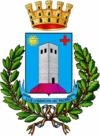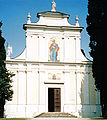Solferino
| Solferino | ||
|---|---|---|

|
|
|
| Country | Italy | |
| region | Lombardy | |
| province | Mantua (MN) | |
| Local name | Sulfrì | |
| Coordinates | 45 ° 22 ′ N , 10 ° 33 ′ E | |
| surface | 13 km² | |
| Residents | 2,686 (Dec. 31, 2019) | |
| Population density | 207 inhabitants / km² | |
| Factions | Barche | |
| Post Code | 46040 | |
| prefix | 0376 | |
| ISTAT number | 020063 | |
Solferino is a small town ten kilometers south of Lake Garda in the Italian province of Mantua ( Lombardy ) with 2686 inhabitants (as of December 31, 2019). The city became famous through the battle of Solferino on June 24th, 1859 and is due to the effects of this battle as the birthplace of the idea of founding the aid organization Red Cross .
The battle of Solferino
On June 24, 1859, as part of the Risorgimento , the Italian aspirations for liberation and independence, a battle between the troops of the Kingdom of Sardinia-Piedmont and France under the leadership of the French Emperor Napoleon III took place near Solferino . on the one hand and the army of Austria on the other. This battle led to the defeat of Austria in the Sardinian War . As a result, Austria had to cede Lombardy via France to the Kingdom of Sardinia-Piedmont. Due to its geopolitical effects, the Battle of Solferino was an important step towards the unification of the Italian provinces into an independent nation state.
Consequences of the battle
- “[...] The sun of June 25th illuminates one of the most terrible spectacles that can be imagined. The battlefield is everywhere covered with corpses of people and horses. In the streets, ditches, streams, bushes and meadows, there are dead people everywhere, and the area around Solferino is literally littered with corpses. Grain and maize have been trampled, the hedges destroyed, the fences torn down, puddles of blood can be found everywhere. [...] "
- (Henry Dunant: A Memory of Solferino. )
The Geneva businessman Henry Dunant arrived in Solferino on the evening of June 24th, as he was with Napoleon III. wanted to talk about business problems in then French-occupied Algeria . He happened to witness the terrifying conditions after the battle. Under the impression of what he saw there, he spontaneously organized help among the population of the surrounding communities. Dunant himself was particularly active in the neighboring town of Castiglione delle Stiviere , where around 8,000 victims of the battle were housed at that time, mainly in the town's eleven churches. In this context, Castiglione delle Stiviere was best known for the slogan Tutti fratelli (Italian: all are brothers ), which was coined by the local women.
- “[...] The women of Castiglione soon realize that there is no difference in nationality for me, and so they follow my example and show the same benevolence to all soldiers who are completely foreign to them. “Tutti fratelli”, they repeat over and over again, touched. Glory to these compassionate women, these young girls from Castiglione. [...] "
- (Henry Dunant: A Memory of Solferino. )
After his return to Geneva, Dunant wrote down his experiences in a book entitled " A Memory of Solferino ", which he had published in 1862 at his own expense and distributed to leading figures from politics and the military all over Europe. Under the influence of this book, the International Committee of Aid Societies for the Care of the Wound was founded in Geneva in 1863 , which has been called the International Committee of the Red Cross (ICRC) since 1876 , and in 1864 the first Geneva Convention was adopted by twelve European countries.
Solferino in the present
Solferino is currently a place with approx. 2,500 inhabitants and is mainly characterized by its historical importance. Even today, farmers in the area often find bone fragments in the cultivation of their fields as evidence of the battle of 1859. Hundreds of thousands of people visit the place every year, which already on the entrance sign indicates its importance as the birthplace of the idea of the Red Cross.
In the village there is a small museum mainly dedicated to the history of the Risorgimento. For example, weapons, uniforms, flags and equipment from the armies involved are on display, as well as contemporary depictions of the conflicts in pictures and sculptures. In the immediate vicinity of the museum on a hill is the Ossario di Solferino bone chapel . In this small church the skulls of 1,413 people who died in the battle and the bones of around 7,000 other victims are kept. The chapel has the following dedication in four languages (German, French, Italian and Latin):
- THE UNITED REMAINS
- DEAD WARRIOR
- Consecrate wreaths
- AND RELIGIOUS PRAYERS
- ENEMIES IN FIGHT
- REST IN THE PEACE OF THE TOMB
- TOGETHER AS BROTHERS
On a mountain at the end of an avenue of cypresses, the monument of the Red Cross, inaugurated in 1959, can be found, on which every national Red Cross or Red Crescent Society is represented by a stone tablet. On the way to the memorial you will find several grave columns in memory of various regiments that participated in the battle and their fallen soldiers. Near the monument is the "Spy of Italy" (Spia d'Italia). The platform of the tower is accessible to visitors, in the entrance hall, as in the museum, some memorabilia from the battle are shown.
To commemorate the battle, a procession with a memorial service at the Ossario takes place annually on Sunday around June 24th. In addition to the dignitaries of the area, military associations and historical as well as local associations with their flags take part. The Italian Red Cross commemorates the origins of this organization the evening before with a torchlight procession (Italian: Fiaccolata ) from Solferino to Castiglione delle Stiviere with participation from many other Red Cross and Red Crescent societies.
In Paris a bridge on the Seine commemorated the battle for a long time .
Geology and landforms
Solferino is located in the area of the terminal moraine of a side branch of the Ice Age Adige Glacier , which forms a wide ring around the southern bank of the Lake Garda basin carved out by the glacier , like an extensive but flat amphitheater with height differences of up to 150 m. The striking moraine hill "La Rocca di Solferino", which bears the above-mentioned "Spy of Italy", is particularly significant at 206 m above sea level .
Town twinning
- Solférino , France, since 1963
- Châtillon-sur-Indre , France, since 2003
literature
- Henry Dunant: A Memory of Solferino. Self-published by the Austrian Red Cross, Vienna 1997, ISBN 3-95-008010-4 ( online at Archive.org )
- Ulrich Ladurner : Solferino - A Short History of a Great Schauplatzes- Residenz Verlag, St. Pölten and Salzburg 2009, ISBN 978-3-70-173151-0 ( Online available as a PDF file , 1.2 MB)
- Pierre Boissier : History of the International Committee of the Red Cross. Volume I: From Solferino to Tsushima. Henry Dunant Institute, Geneva 1985, ISBN 2-88-044012-2
- Caroline Moorehead : Dunant's dream: War, Switzerland and the history of the Red Cross. HarperCollins, London 1998, ISBN 0-00-255141-1 (hardcover); HarperCollins, London 1999, ISBN 0-00-638883-3 (paperback edition)
Web links
Individual evidence
- ↑ Statistiche demografiche ISTAT. Monthly population statistics of the Istituto Nazionale di Statistica , as of December 31 of 2019.
- ^ Liceo Scientifico Statale Enrico Medi: Geologie del suolo morenico , accessed on Aug. 4, 2013
- ^ Associazione "Amici del Gondolin": Le origini geologiche del lago di Garda , accessed on Aug. 4, 2013








